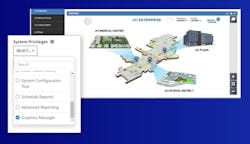How to Maximize the Value of Building Automation Systems
By KAISHI ZHANG, Vice President, Global Product Managament, Building Automation Systems and Control, Johnson Controls
An effective building system is the result of many factors, including energy reduction, regulatory compliance and facility management simplification. However, building systems are often designed and updated based on a piecemeal approach that focuses on a single stage of a building’s life cycle or area of operation. By making updates in isolation or based solely on immediate needs, this approach can limit progress and overlook valuable opportunities to maximize performance.
Fortunately, there’s another way that building owners and facility managers can make buildings smarter, more comfortable, more energy efficient and easier to operate: the life cycle approach. Imagine a life cycle approach as a constant circle in which technology continually monitors building systems and is constantly refreshed with the latest functionality. In this way, the approach can help deliver optimal outcomes from the building’s initial design and build to commissioning and operation and any potential service or retrofit upgrades as the building ages.
An intelligent building automation system (BAS), which connects commercial HVAC, lighting, security and protection systems on a single platform, can make the life cycle approach possible. Facility teams can use BAS technology to monitor assets in real time, automate processes and gain access to data and analytics that help them enhance building efficiency, occupant comfort, safety and more.
Although hardware and devices in these systems may not last for the duration of a building’s lifespan, specific capabilities in dynamic BAS software can help building owners and facility managers ensure that their systems evolve to meet operational and sustainability goals across the full building life cycle.
Driving toward 'zero engineering'
Many currently available building automation systems require specialized expertise to install, program and commission. Because of skilled labor shortages, service providers are using the life cycle approach and implementing plug-and-play BAS technologies and factory-connected assets. This is helping to move the industry closer to the 'zero-engineering' concept.
Zero engineering reduces BAS tool complexity and relies on artificial intelligence (AI) and machine learning (ML) to make processes simpler and more efficient. One way to reduce engineering is by avoiding time-consuming and costly, customized control sequences in favor of standardized ones.
For instance, using proven control sequences according to ASHRAE Guideline 36, High-Performance Sequences of Operation for HVAC Systems (G36) helps to maximize HVAC control stability and provide insights through real-time fault detection and diagnostics.
From factory-connected, plug-and-play assets to zero-engineering BAS technologies, contractors and technicians can reduce the learning curve associated with BAS programming and installation. Instead, they can use their time to focus on value-added services and maximize an organization’s capital expenditure (CAPEX) investment.
Shifting toward 'continuous commissioning'
Following BAS installation and programming, the next step is deployment and commissioning, a process that often requires specialized, on-site personnel, such as a dedicated commissioning agent. This specialist ensures the wiring aligns from both a control and electrical engineering perspective and that the system operates as designed – a process that’s critical to operational success.
In tandem with zero engineering, the industry is shifting toward continuous commissioning.
Using a life cycle approach, engineers and technicians can use connected controls to remotely and continuously commission building automation systems by leveraging the power of the digital thread from the engineering phase to reducing the engineering effort and the need for on-site specialists, as well as to help minimize human error.
Leading service providers with dedicated BAS experts can remotely support local technicians while leveraging software to diagnose commissioning issues and faults. Some service providers have developed workflow tools to guide local technicians with clear, standard processes. This helps ensure that technicians of any skill level can effectively program and commission the system, ensuring systems are ready for use on time and within budget. The first step toward zero commissioning starts with this collaboration between remote experts and local technicians.
Enabling autonomous operations
After BAS commissioning and integration with smart building equipment and systems, the facility team assumes day-to-day operation and monitoring. Through connected controls, teams can remotely monitor and manage a building’s smart assets.
With this enhanced visibility and control, teams can get more value from a BAS which, in turn, optimizes building performance, maximizes operational expenditures (OPEX) and helps achieve positive outcomes. For example, this approach helps:
- Save energy and meet decarbonization goals
- Accelerate return on investment (ROI)
- Advance operational efficiency and enhance reliability
- Maximize system performance
- Simplify building management
- Maintain regulatory compliance
- Strengthen cybersecurity
- Improve occupant productivity, comfort and well-being
Because BAS can be so feature rich, understanding a system’s full capabilities to deliver these outcomes can be a challenge for facility teams. Many teams take advantage of just a fraction of what their BAS can do.
Facility teams and local technicians can get support from the same BAS experts that support programming and commissioning. Using remote capabilities, these experts can connect to a building’s BAS. This allows them to view and assess analytics in relation to outcomes so they can prioritize how to align the system with an organization’s goals and adjust remotely. If needed, BAS experts can also provide remote support to on-site technicians.
Remote assessment can be especially useful for maintenance.
In the current service approach, when there is an issue, a technician must make an on-site visit to determine what is needed. This trial-and-error process can waste time and require multiple visits, potentially extending downtime and impacting comfort, performance and efficiency.
With the life cycle approach, facility managers can leverage BAS data, digital capabilities and remote BAS experts to streamline diagnostics. In some cases, remote experts may be able to address the issue immediately. If a local technician is required, they are able to understand the issue before they arrive, helping them work more efficiently, reducing costs and maximizing the visit’s value.
Deploying future-proof systems
A future-proof BAS is one in which the software application life cycle is decoupled from the hardware life cycle. The service provider continuously upgrades software over time and, when the hardware approaches the end of life, it only takes a few clicks to move the software to a new hardware platform, reducing system downtime. Separating the software life cycle from that of the hardware allows the system to seamlessly upgrade, expand and evolve while it helps reduce costs for building owners and facility managers.
Advanced BAS technologies offer software applications that upgrade within a few clicks. As in the concept of continuous commissioning, some BAS software employs a continuous release model to seamlessly update system functionality.
A continual release model lets operators access new capabilities and features as they’re developed, rather than on a periodic release schedule. This approach gives organizations more control over system functionality, since they can choose which updates and features to implement. As a result, facility teams can be better equipped to respond to new and emerging challenges while achieving their goals.
A smarter, healthier, more sustainable future
Building owners and facility managers can get the most out of a BAS by considering a life cycle approach that optimizes value and achieves better long-term outcomes. By partnering with a building technology supplier with a complete ecosystem of connected technologies, expertise and services, organizations can drive results across the full building life cycle.
Intelligent building automation systems deliver a powerful combination of technology, software, data analytics, remote support and the expertise of local specialists. With these solutions, building teams are well positioned to maximize the potential of their facility and build a future that’s smarter, healthier and more sustainable.
#####



